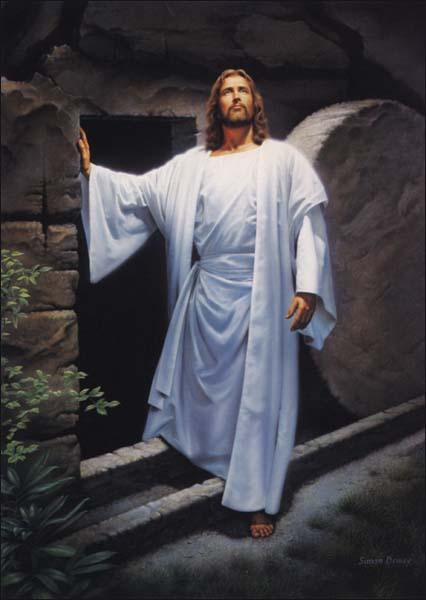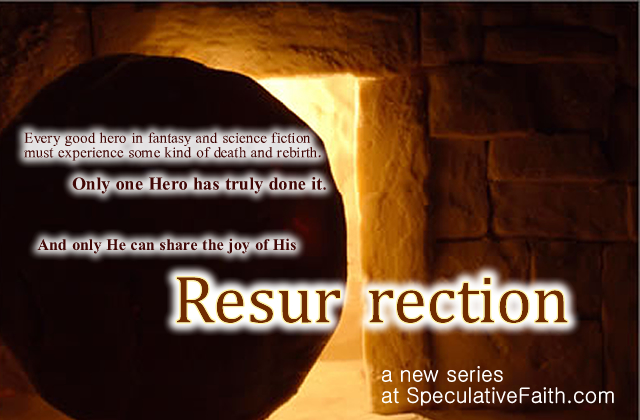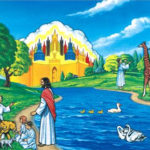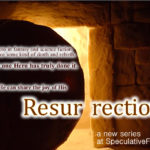Resurrection, Part 2: Christ Is Risen
One week and one day from tomorrow, Christians will be imagining Christ still on the cross.
This piece shouldn’t detract from that. In fact, bookmark it to read on Sunday morning if you like. One can’t skip to the Resurrection without His death. Yet one shouldn’t also emphasize His death so much that His Resurrection effectively becomes an afterthought.
For centuries Christians of all denominational stripes have agreed: all present and future resurrections began with Himself. Without that fact, our faith is null. 1
Divine postmortem
Plenty of sermons and materials teach about how He died physically: asphyxiation from the cross added to the loss of blood from the thorns on His head and the scourging of His back. “Five bleeding wounds He bears,” says the hymn: two in His hands, two in His feet, and the one in His side where the soldier stabbed His dead body with a spear to see if He was dead.
What we don’t consider as often is how He might have risen.
So how did He do it?
Miraculously — we can say that for sure.
So “how?” is the wrong question. Instead we may ask: Whoa, what did it look like?
For whatever reasons — emphasis? budget? desire for reverence? — Bible-films like The Passion of the Christ and The Gospel of John like to skip whatever special effects would be necessary to reenact the Resurrection. No, I don’t mean the stone rolled away, the angels sitting there, or people running around seeking or finding Him. I mean the metamorphosis. The moment He yanked Himself away from death. The moment life reentered His body.
Imagine the scene …
Damp blackness is stifling. You may sense the walls so close and the rough-hewn ceiling hanging low. A stench fills the chamber, the odor of death. For about two days2 the mutilated body of Jesus has lain here, as motionless as the rock.
No sound comes from outside the heavy stone rolled before the cavity’s tiny entrance. If you could go outside, you might see the garden-like area beyond — and at least two Roman soldiers stationed at the entrance, with an official government seal upon the stone.
All is dark and still. Does dawn approach? Did the sun rise with the Son?
Now comes a tremor, throbbing in the earth. With grunts, both guards snap to attention.
Inside the tomb, stone walls shake. Pebbles rain from the ceiling. Quaking ground rumbles even louder. Will the cave fall in? Is that a glow? Yes, near the body, faint at first, golden with holiness, and now with an eye- and ear-splitting flash it bursts like fire in the tomb.
Under the layers of thick, dirty, and bloodstained fabric, it begins.
Resurrection.
Divine energy courses through His dead body. Cellular activity begins. Life returns. A re-living heart starts to pump, slowly at first, then faster, faster.
Sparkling power bursts through every artery and vein and nerve and muscle, repairing tears, drawing together torn fragments, regenerating and re-sealing the shredded flesh in His back. Other wounds disappear like they never existed. On his head the horribly deep scratches from the mocking thorn-crown vanish as if time itself reversed.
What of the metal shrapnel from the whip that may have lodged in His back, or thorn bits that may have broken off into his scalp? May they simply dart out into the grave cloths? Or do they crumble into nothing as if vaporized?
As for the five other, formerly bleeding wounds of His …
They will remain. He will keep them as evidence of His sacrifice, and to prove that His body, though new and with supernatural powers, is the exact same body as before.
That body is already rising onto His muscular, firm legs that pulse with power and glory.
Tissue mends itself, just beneath His wrists and on His feet. Blood vessels and muscles, already woven back into better-than-perfect health — they may be shifted away from His evidential wounds so they will never bleed again. Flesh around the holes in his hands hardens into new, tougher, impenetrable skin, yet still showing the scars.
On His feet, the nerves, same as all through His new body, are impervious to pain. Yet they still show the nail scars on either side.
In His side — between His underarm and ribcage? — the wound from the spear piercing remains. But it will never again bleed or be pained. Even as He feels the skin around the wound adjusting itself, does He anticipate in days showing that wound to His disciples?
Is His awareness — the spirit He gave up after He breathed His last3 — already reunited with His human body? Or did His awareness return4 seconds later? Perhaps all along He is aware that He has returned, that His body is being rejuvenated, that He has won!
How long does this transformation take? Several power-charged seconds or an instant?
 Do His eyes open, wrapped in the grave cloths? Or does He keep them closed while He lifts off the stone slab? Does He pass supernaturally through the cloths — or does He, with a cry and mighty shudder like the earthquake itself, burst out of them?
Do His eyes open, wrapped in the grave cloths? Or does He keep them closed while He lifts off the stone slab? Does He pass supernaturally through the cloths — or does He, with a cry and mighty shudder like the earthquake itself, burst out of them?
Death could have never held Him.
And His new body — a prototype of our future resurrected bodies5, though far more powerful — has amazing superhuman abilities we can only guess about from later descriptions in the Gospels.
Now He has left His grave clothes; He may wear some other clothing supernaturally given. Dried blood has disappeared from His glorified skin. His wounds are perfectly healed, His scars visible. Blazing with glory, He stands to His feet and walks through the tomb.
The stone is gone. The earthquake has ceased. Guards have fainted at the sight.
Into the dawn the Son strides forth to spread the news — and to share His Resurrection.










































Additional fun tidbit: When a Jewish carpenter was finished with a project, he would lay a folded cloth on it to signify to the buyer than it was completed.
So Jesus took off his headcloth and folded it up by itself to signify that his work was complete. Peter and John recognized it when they looked in the tomb.
Aww, I love DETAILS! They make me see things so much more clearly and think about it more.
Love this!!! That is so true that we tend to emphasize what happened on the cross, and then be vague about the resurrection. I guess it’s because the Bible doesn’t give us details; it just tells us the tomb was empty.
Praise the Lord for His wondrous works!
Something that helped me recall why Scripture doesn’t give details about some things (such as, say, a person’s appearance) was a church conference at which the facilitators reminded listeners of the tremendous difficulty of writing back then. Thus the more important details rose to the top, and repetitions especially meant pay attention here, this part is so important we painstakingly inked it out twice!
A lack of Resurrection speculation in the four Gospels is also, I think, a secondary apologetics argument for His Resurrection. After all, made-up myth-writers would have gone to town about the “specials effects” of it all. Instead it’s very realistic.
I’ve heard the thought that His body just disappeared at the moment of resurrection and reappeared outside the graveclothes. I’ve heard it said that He really didn’t need to roll the stone away to escape. Evidently, from this view, the angel must have rolled the stone away, and blasted the guards, for the very sensible reason of providing conclusive evidence so that the faith wouldn’t be dismissed as an accident.
At any rate, I think the mystery in the Gospel accounts of the resurrection are important. The events surrounding the life of Jesus are the most mysterious things that have ever happened in human history. He returned different, transcendent, and it does seem like spatial restrictions had no bearing on His body.
Thank you, Stephen, for daring to speculate. Christ’s resurrection is the ultimate narrative catharsis and yet, as you said, it’s typically glossed over in retellings of the gospel.
It’s easy to kill off the hero yet hard to bring him back. And the hero must die, or at least be perceived to metaphorically die, in order to rise again. If we the audience were to anticipate the specific logistics of such a resurrection, it’d cease to be a surprise and thus lose the raw emotional power which impels us to leap for joy in response. And yet the victory can’t simply materialize out of thin air: a deus ex machina is reflective of a confused and desperate storyteller willing to break his own rules to escape a tight place. Once revealed, the solution must make sense. Resolution has to be totally unexpected, yet completely inevitable. Like an appeal to deeper magic. Like a climactic victory over death which, though foreknown before the creation of the world, nonetheless eluded the comprehension of those present at ground zero until the last possible second. In achieving the narratively impossible our example, as per usual, is Christ.
You’re not quite at the part where Jesus is seen, so please pardon my jumping ahead. One of the fascinating things about Jesus’ resurrection that I’ve heard pondered is why Mary, and those on the road to Emmaus, didn’t recognize Him. This argument goes back to the passages that talk about the beating and torment Jesus received prior to His crucifixion, how the guards had pulled out His beard. Unrecognizable from transformation, instead of unrecognizable from torture recovery, is a new thought. How would he change? Why? Why keep only the five punctures? (I would have kept every mark, no matter how small or private.) In His newly resurrected body, was it harder than usual not to glow?
And what about the time He spent elsewhere for those three days? In a Seder feast, three pieces of matzoh are veiled together on a plate. The middle one (the afikomen) is broken during the feast, wrapped in a napkin, and hidden away for three hours. At the conclusion of the meal, the children are sent to find it and redeem it for a prize. This is an old custom that in Messianic Passovers takes on a precious layer of meaning, as the body of Christ is unveiled and shared among the faithful who have sought Him. Where was our dear afikomen during that hiding time?
I wouldn’t describe the Resurrection as “rejuvenation” or even “revitalization”; while either of those would be miraculous enough, neither of them quite fits how he himself described it (in the passage beginning “I am the Good Shepherd”: “The reason my Father loves me is that I lay down my life–only to take it up again. No one takes it from me, but I lay it down of my own accord. I have authority to lay it down and authority to take it up again.”), and neither of them quite describes the difference between his body before his death and his body after his resurrection.
While we do have to make sure to steer clear of the idea that resurrection involves new bodies unconnected to the old ones, it’s not merely that we get our bodies back, alive when they’d been dead; there is a qualitative difference between “perishable” bodies and “imperishable” ones, between mortality and immortality, between natural life and supernatural life. The post describes this (albeit in more prosaic terms than I would use—but, then, I’m something of a poet), but I think it’s important to emphasize it.
Turning to speculation:
Like Bainespal above, I think that he passed through the cloths and the walls of the tomb as he did the walls of locked rooms later; the stone was rolled away so that the women and the disciples could see, not because it was any barrier to him. And also, perhaps, to show that God doesn’t do things by halves.
Mmm … While the mythic poems of antiquity are full of such details, I think that’s more a consequence of their genre and form (I’m very familiar with the tendency to choose a particular word or phrase to fill out a particular syllabic pattern), and perhaps their cultural heritage (neither the Hebrew Scriptures nor the Septuagint is much given to extensive description), than of their origin in human invention; the Gospels make no pretense of being literary poetry in the Homeric style. (And I get the impression that the myths outside the epics are sparse, rather than full of details.) Also, I found Lewis’s point about incidental details (referring specifically to Jesus writing in the dust when challenged with the case of the woman caught in adultery) being evidence for the Gospels’ historicity to be rather compelling, and it doesn’t seem entirely fair to argue that the inclusion of some details is evidence for their truth and the absence of other details is evidence of the same thing.
There are three things at work here: first, that resurrection bodies are recognizably the same yet different, somewhat like I am recognizably similar to my five-year-old self, but if you knew me then, hadn’t seen me since, and ran into me unexpectedly tomorrow you probably wouldn’t recognize me at first; second, that it’s not unreasonable to dismiss a conclusion that seems impossible (this living man before me is the man I saw die in anguish mere days ago) in favor of a less far-fetched one (he’s the gardener, or a stranger who bears some resemblance) without even thinking about it; and third, that human perception is fallible, and it takes divine revelation for us to see even the obvious truth (which is part of why these accounts are included by the Gospel writers, I think).
We know so little about metaphysical geography and topology that I’m not going to speculate on that point. However, it seems to me that part of what he was doing during that time was “keeping the Sabbath”—even in laying his life down and taking it up again our Lord remained perfectly righteous.
[…] Christ Is Risen —> We Are Risen; We Will Rise —> Creation Will Rise. […]
[…] Corinthians 15:23 summarizes the first two resurrections. Jesus Christ is risen. In Him, His people are also risen, and will rise. “Then comes the end, when he delivers the […]